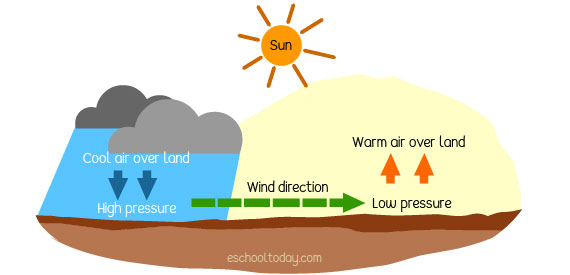- Winds
What is wind and how does it form?
‘Wind’ is simply the flow of a huge amount of air, usually from a high-pressure area to a low-pressure area.
How are winds formed?
Typically, this begins with the sun’s radiation, which is absorbed differently on the earth’s surface. The earth’s surface is heated differently because of scenarios like cloud cover, mountains, valleys, water bodies, vegetation, and desert lands.
As a result of this uneven heating, the earth’s surfaces will vary a lot in temperature. Air on surfaces with higher temperatures will then begin to rise because it is lighter (less dense). As the air rises, it creates low atmospheric pressure. Air on surfaces with cooler temperatures sinks (do not rise). The sinking creates higher atmospheric pressure. This behavior of warm gases or liquids moving upward and replaced by cooler particles is called Convection. The energy moving during convection is called convectional current.
Important:
Hot air rises, and cool air sinks. That brings about spatial differences in atmospheric pressure, caused by uneven heating.
Let us see this illustration below showing pressure and wind direction:

In the diagram above, notice how cool air falls, resulting in high pressure, and moving towards regions of low pressure.
Anywhere and each time there are differences in atmospheric (air) pressure, there will be wind because air will move from the high-pressure area to the low-pressure area. It also means that winds may be even stronger where the difference in the air pressure is greater.
A good example is how tropical depression forms, where warm air over hot tropical waters rises, and high-pressure cold air quickly rushes to fill the space.
Is it true?
It is believed in Space study that Neptune and Saturn are the two planets that have the strongest winds. Research this and share your findings with us.
